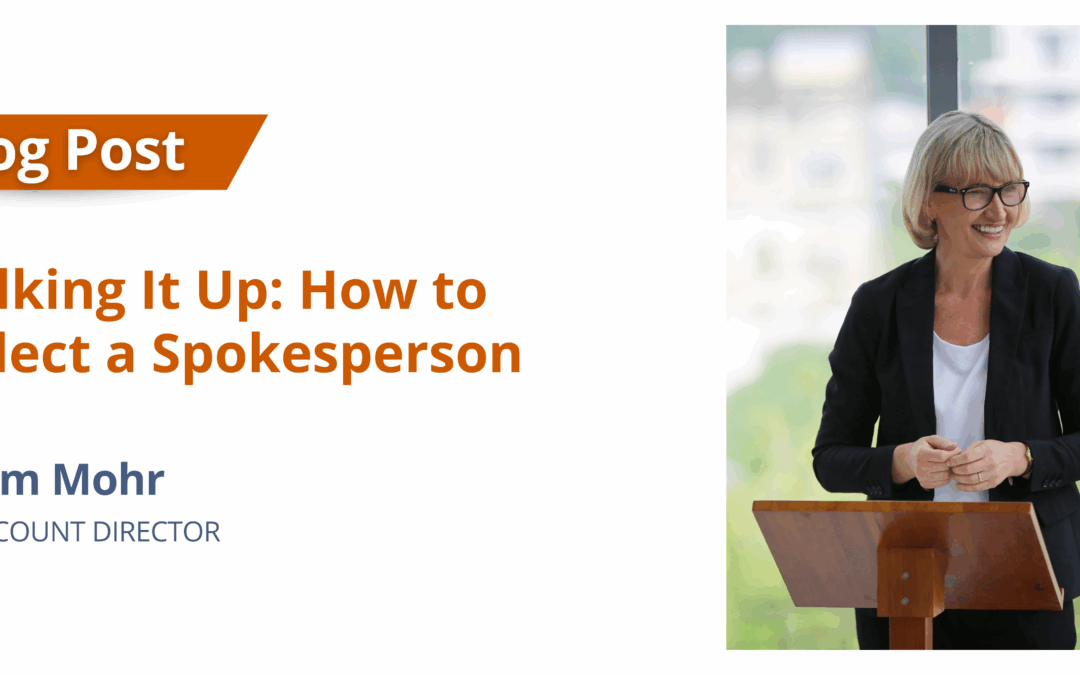
Talking It Up: How to Select a Spokesperson
Many times, when we think of a brand that we know and love, we automatically associate that organization with the person who represents it in the public forum. Apple, the Dallas Mavericks, Nike and Microsoft have all had a notable spokesperson associated with their brand. While you may not have Michael Jordan on your bench, it’s as important for your organization to have a trusted frontman or woman to tell your story to the world.
So, Who Should You Choose?
While it may seem like a given to choose the head of your company, a recent article from pr.co cites research that shows the CEO is not always the way to go. Sure, the top boss might know the company and the technology better than anyone else, but does that person have what it takes to relay this knowledge in a relatable way that members of the media and the public can grasp and connect with?
When selecting a spokesperson, credibility is key. Even if your company exec is an expert on your product or service, it’s of the utmost importance that they have experience and knowledge that extends beyond the company talk track. Often, executives who have lived another life as a clinician, health system leader or hands-on data engineer make great spokespeople. They have worked through and grappled with the technology your solution is solving and can speak firsthand to the perils of the problem and the importance of a solution to like yours. Titles such as Chief Medical Officer and Chief Nursing Officer are often great choices. We’ve recently seen great interest in Chief AI Officers, and these executives are often adept to speak not only to the current state of technology, but they can offer insights into how we could see technology change in the near and long term.
Importantly, would you find the person you’re considering to speak for your company interesting to talk to over coffee or at a dinner party? Do they have a unique perspective? Are they passionate about finding a solve to the problem you are addressing? Media are people too, and just like you, they can get bored easily if a spokesperson comes across as static or rehearsed.
Another consideration: In key strategic situations, a company may select someone who is controversial to speak for the organization. Generally speaking, it’s best to avoid someone who runs the risk of alienating your customer base. If you’re considering a controversial or confrontational figure, work closely with your PR agency and internal stakeholders to weigh the pros and cons.
The more, the merrier?
A mistake some companies make lies in thinking they must choose just one person to speak for the company. This couldn’t be further from the truth. While you do want to maintain a consistent brand voice and drive home key talking points that have been determined through a thoughtful process, it is perfectly fine and often even preferable to have more than one spokesperson.
When using multiple spokespeople, differentiate based on each person’s area of expertise. Perhaps your CEO would be the one to give an interview to Axios a funding round, while your CMO would talk about the challenges of clinician burnout in a chat with a provider-focused podcast. Be deliberate when determining how many people will speak for your company. While a couple key leaders focused on disparate topics is great, too many voices can muddy the message and leave your audience confused. Additionally, determine who will speak for the company during a crisis (often your CEO or board chair) and develop a crisis communications plan that is shared with all relevant stakeholders in advance.
How to Build a Thought Leader
Once you have determined who will speak for the company, create a plan to introduce that person to the company. A PR plan should include thought leadership articles from your spokesperson that will be pitched and placed in key trade publications. To build credibility for your spokesperson and to secure earned placement, these pieces should cover a topic relevant to your space and avoid direct mention of your company. If your piece sounds like a sales pitch for your tech, it won’t see the light of day. Further, develop a social media content calendar that details posts for the company and your key spokespeople. Your audience wants to see that your leadership is part of the conversation in their area of expertise, so posting relevant articles from outside your company as well as engaging with outside content are all effective strategies.
A key part of being a spokesperson is, of course, speaking. Well before you schedule your first interview, schedule comprehensive media training for anyone who might be speaking on the company’s behalf. Amendola Director of Media Relations Grace Vinton offers tips for making the most of opportunities.
When it’s time to pitch, again, focus on broader areas of interest and prepare talking points in collaboration with your spokesperson and other stakeholders. You’ll often be given the chance to talk about what makes your company different, but let’s face it – no one likes someone who only talks about themselves all the time.
Additional Pitching Opportunities
While we often focus on health tech and healthcare trade publications and podcasts, Amendola Senior Writer Brandon Glenn reminds us in this recent blog post not to neglect mainstream media. Consumer and local outlets can provide golden opportunities in the right situations. Business publications such as the Wall Street Journal will often publish hiring news, so this can be a great option if your spokesperson has recently joined the company – a great way to get their name in front of a large audience. Axios loves big financial news, so if your spokesperson is willing to talk about a recent funding round or lucrative business deal, don’t overlook this mainstream outlet. Are you hosting a user meeting or participating in a charity even in the city where you’re headquartered or elsewhere? Try for an interview with the local business journal or morning news show.
Remember, too, that media is changing. While landing big publications is often the goal, smaller outlets can offer a precise target audience. Increasingly, bloggers and hosts of smaller podcasts are targeting the very audience you’re trying to reach.
Conclusion
Selecting a spokesperson is one of the biggest decisions you’ll make for your company. But don’t worry – remember these steps that we’ve covered here and you’ll be on your way to putting your company on the right path.
